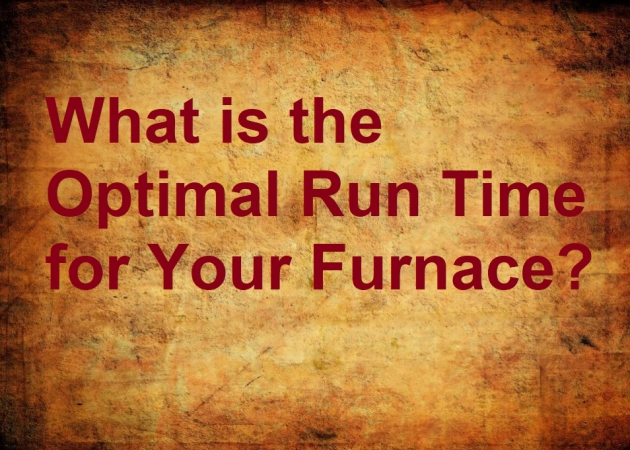At this time, we rely on our furnace more than usual and many people worry about the optimal run times for their furnace. If your furnace is working properly, it should be completing a heating cycle two or three times per hour. The length of each cycle will vary depending on the external weather conditions and how far the temperatures have dropped. When the weather is mild, a furnace will usually run for ten or fifteen minutes, but as the conditions turn colder, the cycle will be much longer. In this article, we will take a closer look at run cycles and some factors that can affect the times.
Why is This an Important Topic?
Aside from the obvious waste of energy that can be expended during an extended furnace run time, there are other considerations. When a furnace is behaving in this manner, it can be a sign that there is an underlying problem. The furnace may be turning on and then off again in quick succession which is known as “short-cycling”. This can cause extra wear and tear on the components in your HVAC system. There may be more frequent repairs and failures and it may even lower the expected lifespan of your system. Let’s take a closer look at short-cycling in more detail.
What Are the Causes of Short-Cycling?
If you’re experiencing short-cycling, it can be a frustrating experience and it can have expensive consequences for your budget. There are three main reasons why your furnace is short-cycling, they are:
1. The Thermostat
The thermostat is the brain of your entire heating and cooling system. As you might imagine, any problem with this crucial component can affect the performance dramatically. When you examine your thermostat, does it seem to be working as intended? The display should be lit up and the temperature readings should change as the thermostat is adjusted. If the thermostat is not functioning properly, there are few possible causes to investigate before you call your local HVAC specialist.
Many people don’t know that their thermostat contains a sensor to gain an accurate reading on the indoor temperature. This reading is used as a baseline to call for heat or cooling as needed and it can be prone to false readings. If the sensor is dirty or it has failed entirely, it may be calling for heat when it is not required, which can lead to short-cycling. This can also occur if the thermostat has been placed near a sunny window or heat register, where it will feel warmer than the rest of the room. Finally, one of the easiest problems to fix is a failed thermostat battery, which could cause intermittent performance.
If you’ve cleaned the internal case of the thermostat and changed the battery, and it’s still not working correctly, it’s time to contact your local heating and cooling technician. The unit may have failed and a replacement or even better an upgrade is required. Switching to a smart thermostat will allow you to monitor your system remotely in real time via a Wifi connection. This will improve the performance and energy efficiency.
2. An Oversized Furnace
Many homeowners believe that installing the largest furnace they can afford is a smart move. But, this isn’t true, a furnace must be closely matched to the home based on a number of criteria, including size, orientation, insulation levels, and more. If the furnace is too large, it will heat the space too quickly and then shut-off before the cycle is complete. This is short-cycling and it will place a great deal of stress on your heating system. Before you get a new furnace, it’s essential to carry out a load calculation to find the right size for your home. This is a complex calculation that should be carried out by your local HVAC specialist to ensure that it’s accurate.
The installation of the wrong sized furnace is common when special deals are available. Some HVAC companies don’t test their systems or carry out load calculations at all. Sadly, any problems can be your sole responsibility when there is no warranty in-place and this can be an expensive proposition. Choose a reputable HVAC company to install and maintain your system and you will save money in the long-term.
3. Overheating Problems
A gas furnace uses a heat exchanger, this heats the air supply that passes through and the treated air is then distributed throughout your home. This is an essential component and it has a built-in safety feature to prevent total failure. When the heat exchanger overheats, it shuts down and when it cools off, it will start again to heat your home. This can cause short-cycling as the on and off again sequence repeats.
The root cause of this problem is the creation of too much heat in the furnace. This can damage the heat exchanger, which would be very expensive to replace. There are a number of possible causes including dirty air filters, blocked vents, and registers, blocked exhaust pipes, closed vents and registers, and a lack of maintenance. So, it’s important to change the air filters regularly, keep vents and registers clear, and invest in regularly scheduled maintenance.
In Conclusion
If your furnace was working fine and it’s recently started to short-cycle, it’s likely that the problem is easier to fix. After all, you know it was working well, but the air filter may need a change or there could be a fault in the thermostat. But, if you’ve recently moved into a new home with a furnace already in-place or you’ve just had one installed, the root cause may be different. The furnace may be too large or inefficient and this can lead to higher energy bills and frequent repair bills. Short-cycling cannot be ignored, the problem will not improve without intervention and earlier action is always the best option.
If you’re worried about a short-cycling furnace or you want to schedule a tune-up, contact your local HVAC specialist today.

